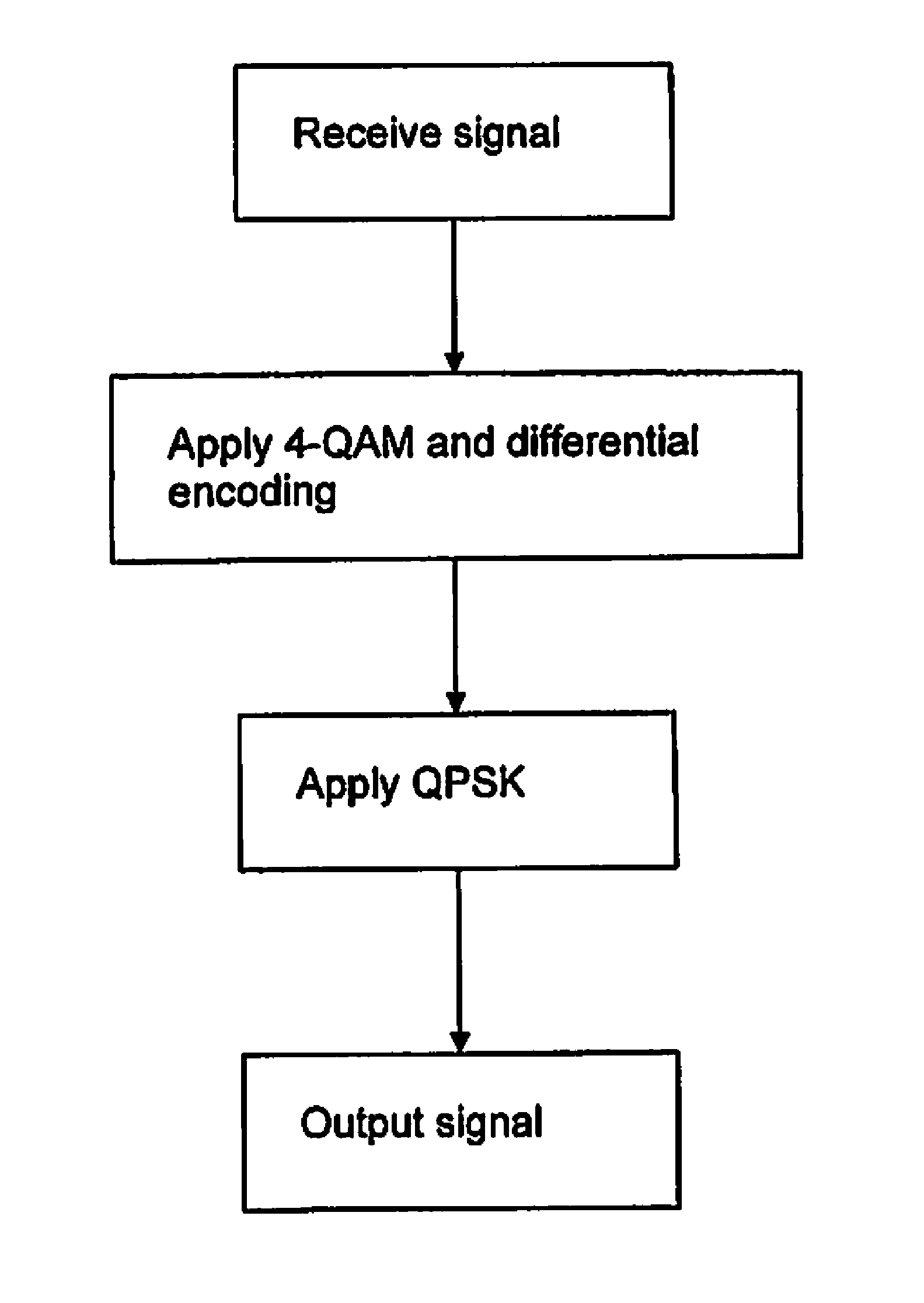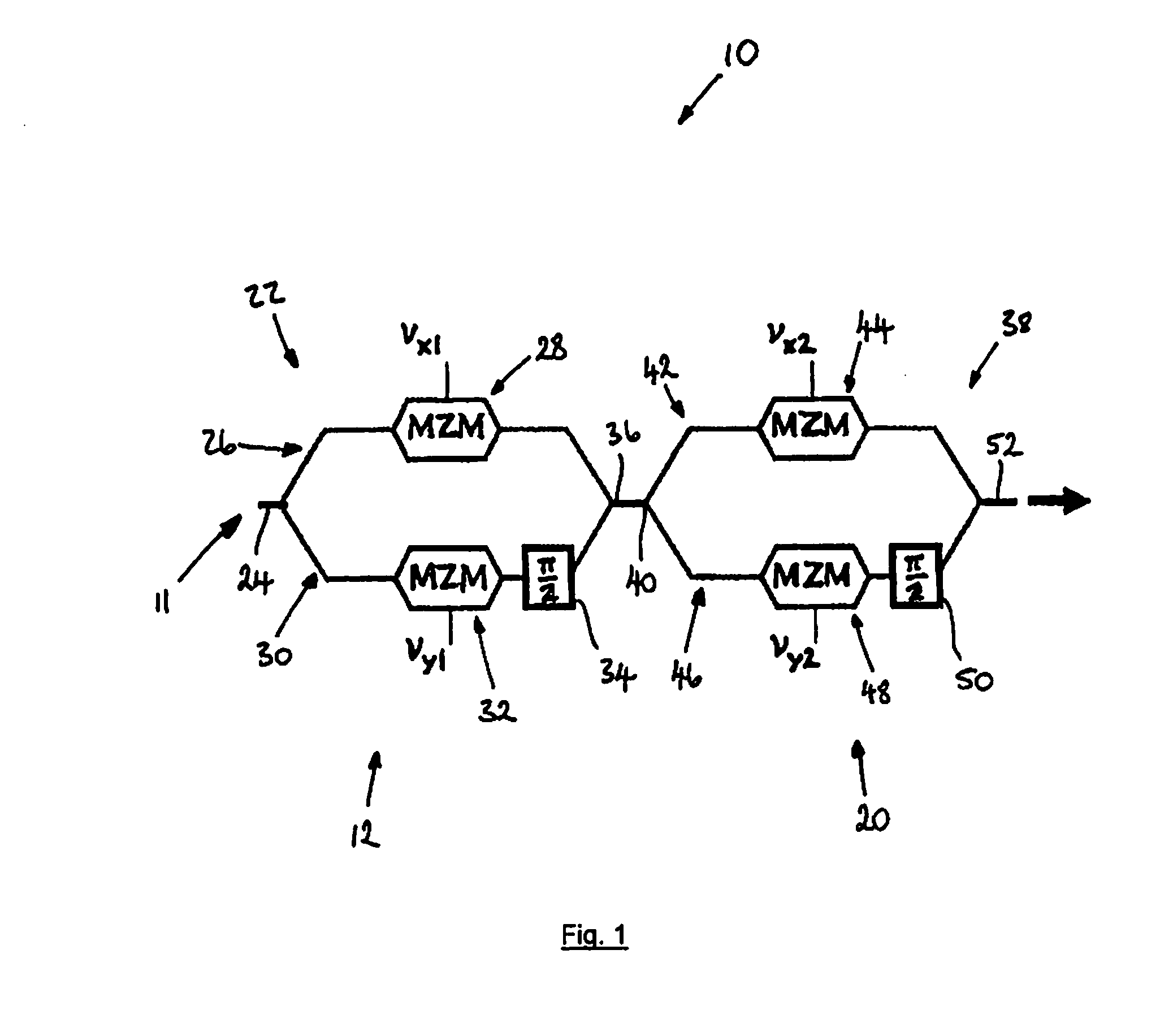Optical signal modulation
a technology of optical modulator and optical signal, applied in the field of 2nquadrature amplitude modulation (qam) optical modulator, can solve the problems of complex driving voltage scheme, less attractive transmitter for the implementation of 100 gbit/s systems, and difficult to achieve the effect of avoiding heavy distortion and stable decision points
- Summary
- Abstract
- Description
- Claims
- Application Information
AI Technical Summary
Benefits of technology
Problems solved by technology
Method used
Image
Examples
first embodiment
[0065]Referring to FIGS. 1 to 4, the invention provides a 2n-quadrature amplitude modulation (QAM) optical modulator in the form of a 16-QAM optical modulator 10 comprising an optical input 11, a first optical modulation apparatus 12, and a second optical modulation apparatus 20. In this embodiment, an optical signal to be modulated is received by the optical input 11 and coupled to the first optical modulation apparatus 12, which applies a quaternary aptitude modulation scheme to the optical signal, generating an intermediate optical signal.
[0066]The intermediate optical signal is then delivered to the second optical modulation apparatus 20, which is configured to selectively rotate the phase of the intermediate optical signal. A 16-QAM modulated optical signal is thereby output from the optical modulator 10 which has a square constellation diagram 19, as shown in FIG. 4, comprising 16 constellation points 16 distributed across the 4 quadrants of the constellation diagram.
[0067]The...
second embodiment
[0076]In use, a method of 16-QAM modulation according to the invention is implemented using the 16-QAM optical modulator 10, as illustrated in the flow diagram of FIG. 6a. An optical signal to be modulated is received by the optical input 11 of the 16-QAM optical modulator 10, and is coupled to the optical input 24 of the first I-Q modulator 22, which applies a quaternary amplitude modulation scheme (4-QAM) having the constellation diagram 14 shown in FIG. 2. Differential encoding is applied to the first two bits via the drive voltages (Vx1, Vy1) applied to the first and second Mach-Zehnder modulators 28, 32. The resulting intermediate optical signal output from the first I-Q modulator 22 is coupled to the input 40 of the second I-Q modulator 38, which applies a QPSK modulation having the constellation diagram 39 as shown in FIG. 3. The phase of the intermediate optical signal is thereby selectively rotated, causing the constellation points of the intermediate optical signal, as sho...
third embodiment
[0078]Referring to FIG. 7, the invention provides a 16-QAM optical modulator 60, which is substantially the same as the 16-QAM optical modulator 10 of FIG. 1, with the following modifications. The same reference numbers are retained for corresponding features.
[0079]In this embodiment, the second optical modulation apparatus 20 comprises a phase modulator 62 operable to selectively apply a phase rotation of 0°, 90°, 180° or 270° to the intermediate optical signal output from the first I-Q optical modulator 22. The phase rotation provided by the phase modulator 62 similarly inherently applies four quadrant differential encoding to the modulated optical signal.
PUM
 Login to View More
Login to View More Abstract
Description
Claims
Application Information
 Login to View More
Login to View More - R&D
- Intellectual Property
- Life Sciences
- Materials
- Tech Scout
- Unparalleled Data Quality
- Higher Quality Content
- 60% Fewer Hallucinations
Browse by: Latest US Patents, China's latest patents, Technical Efficacy Thesaurus, Application Domain, Technology Topic, Popular Technical Reports.
© 2025 PatSnap. All rights reserved.Legal|Privacy policy|Modern Slavery Act Transparency Statement|Sitemap|About US| Contact US: help@patsnap.com



